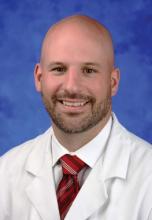A residency program that stresses minimally invasive hysterectomy as the preferred procedure for benign disease is a feasible undertaking, providing valuable surgeon experience and excellent patient outcomes, according to Dr. Joshua Kesterson.
Of 537 hysterectomies for benign disease performed in a single year at one such program, 526 (98%) were begun with a minimally invasive approach, and 517 were completed that way with a resident as the lead surgeon or the first assist, Dr. Kesterson reported at the minimally invasive surgery week annual meeting and endo expo. There were nine conversions to open surgery in the entire group, for a 96% completion rate, said Dr. Kesterson, a gynecologic oncologist at Penn State Milton S. Hershey Medical Center, Hershey Pa.
Surgical training that embraces minimally invasive techniques is a pressing need, he said in an interview. Despite the ever-growing evidence that the technique is associated with decreased pain, fewer infections, fewer gastrointestinal complications, and a quicker return to normal activities, about 60% of hysterectomies are still open procedures.
"Residency training programs around the United States are consistent with that 60% abdominal hysterectomy rate," he said. Recent residency data indicate that the average surgical resident will complete 64 abdominal hysterectomies, 18 vaginal hysterectomies, and 23 laparoscopic hysterectomies during training.
In 2009, the division of minimally invasive surgery at the Hershey facility decided to place more emphasis on a minimally invasive approach to gynecologic surgery. At the meeting in Reston, Va., Dr. Kesterson reported the first full year of safety and surgical outcomes data for minimally invasive hysterectomy in the residency training program.
During 2010, residents acted as the lead surgeon or first assist on 537 hysterectomies for benign disease. Indications included abnormal bleeding, pelvic pain, fibroids, endometriosis, and prolapse/incontinence.
The patients were a mean of 45 years old, with a mean body mass index of 30 kg/m2. The mean uterine size was 11 cm, and the mean uterine weight, 199 g. About a fourth (22%) of the patients had a prior cesarean section.
The majority of the surgeries (526, or 98%) were started with a minimally invasive approach; 18% of these were vaginal hysterectomies and the balance involved laparoscopic surgeries. Of these, 517 were completed as minimally invasive procedures, for a total minimally invasive completion rate of 96%.
There were nine conversions to open procedures. Conversions were due to a lack of visualization (1 case), abdominal adhesions (1), homeostasis (1), and repair of bowel (3) or urinary tract injury (3). There were 12 reoperations for cuff abscess or dehiscence.
The mean operative time was 86 minutes, with a range of 30-390 minutes. The mean blood loss was 95 cc, and the mean hospital stay, 1 day.
All of these surgical outcomes are comparable to those achieved by experienced gynecologic surgeons, which were reported in a 2010 Cochrane review. The review included 34 studies comprising 4,500 women who underwent minimally invasive hysterectomy for benign disease.
"Our operative time of 86 minutes compares favorably to the mean review time of 121 minutes. Our reported blood loss was 95 cc vs. 311 cc, and our hospital stay was 1 day vs. 3 days."
The urinary tract injury rate in Dr. Kesterson’s study was 1% compared with 3% in the Cochrane review, and the vaginal cuff infection rate was 2% vs. 4%.
Despite the results, which show that a residency training program can achieve outcomes similar to – or better than – those of experienced surgeons, the Hershey program remains "an outlier," Dr. Kesterson said at the meeting presented by the Society of Laparoendoscopic .Surgeons and affiliated societies.
"Even though a majority of surgeons would likely agree that minimally invasive surgery is associated with the least morbidity and mortality, it seems like it’s not being offered as often as it could be. I really don’t understand the hesitation at academic centers," especially when operative data are so compelling.
Surgeons who know how to perform these procedures will have a marketable skill and one that is likely to become even more in demand, Dr. Kesterson added.
"I counsel medical students to look for centers that have programs like this. Consumers have become much more educated and are taking a more active role in making decisions about their treatment. They would rather have a surgery with fewer complications and less scarring. I hope the tide is shifting on how we educate our surgeons."
Dr. Kesterson said he had no relevant financial disclosures.


